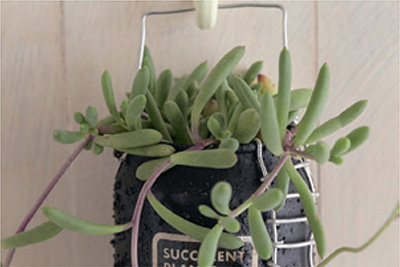Spring/Fall Types
Othonna capensis “Ruby Necklace”

Characteristics of Ruby Necklace
Ruby Necklace is a member of the Asteraceae family, and even in the middle of winter this plant will produce small, yellow, chrysanthemum-like flowers one after another. Its stems are purple vines that creep out and spread in all directions. You can let the vines dangle from the pot and enjoy Ruby Necklace as a hanging plant. There is also an O. capensis that has the same shape as Ruby Necklace but is completely green in color. Both are robust plants and are strong against the cold.

Points to Check when Buying
Avoid plants where the stem has grown too long and spindly. Instead, select ones that are full of life and have lots of leaves.

Soil Composition
Mix 5 parts small-grain Akadama, 3 parts Kanuma soil, and 2 parts mulch for a ratio that has good drainage, water retention, and breathability. Add a layer of gravel like large-grain Akadama or pumice to the bottom of the pot.

Fertilizer
When you transplant a succulent, add a layer of granular base fertilizer on top of the layer of gravel.
How to Transplant
When the roots have stretched out in their container, pull out the plant and massage the old soil from the roots. Spread the roots apart and add in new soil. Leave the plant in partial shade for about a week, then move it to a sunny area and begin watering.

Pour in the slightly dampened new soil. When you have finished transplanting, lightly tap the pot to level the soil and place the plant in partial shade to take root.
How to Propagate
You can remove a single leaf from a stem or cut one of the vines in the middle to use as a cutting. For plants that have grown large, you can also propagate through division.
Leaf Cutting

Place the leaf you removed from the succulent stem on the surface of dampened soil, and after about 10 days the leaf will begin to take root and sprout. When your new plant has grown 4 or 5 leaves, pull it from the soil, taking care not to injure the roots, and transplant it.
Stem Cutting

If you let the cut vine creep across the surface of the dampened soil, it will take root after about 10 days, so just leave the plant to grow.
※ When the plant has produced roots, begin watering it normally.
Key Points for Growing Ruby Necklace
This robust plant grows at a rapid pace, so when it fills up its pot, transplant it to a larger one. Ruby Necklace thrives in places with sunlight and good ventilation, so let it sit outside during spring and fall. It should be fine even if exposed to the rain. Growth will slow somewhat during the hot and humid days of midsummer, so move your succulent into partial shade. Fungus can develop and cause root rot if you overwater, so make sure the soil in the pot is completely dry before giving lots of water.
Cultivation Calendar

Succulent Advice Q&A
Q My plant’s leaves used to be full and plump, but now they’ve wilted!
A The reason your plant is weakened and wilting may be because it has root rot from overwatering. First, pull the plant from its pot and remove any dark, damaged roots. Then, transplant it to fresh soil. If you transplant during a growth period in spring or fall, resume watering after one week. If you transplant in summer or winter, wait until the plant enters a growth period to resume watering.


Ruby Necklace gets its name from the vibrant red of its stems.
Members of the Othonna Genus

O. capensis “Little Pickles”

O. clavifolia *Dormant during summer

O. herrei *Dormant during summer